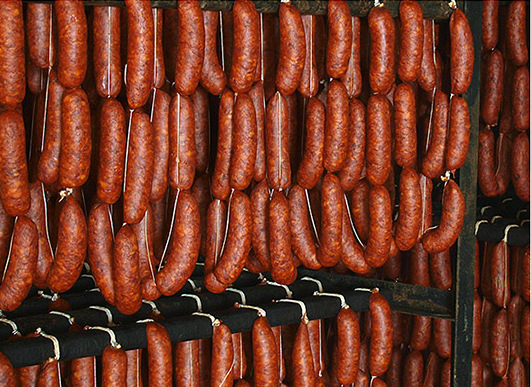Chorizo is a cherished Spanish dish that has been around for centuries. The sausage has different variations depending on which Hispanic country someone is in, but continues to be highly loved and a top choice for a meal. Though chorizo is very high in bad fat and full of sodium; causing major health problems around the globe, dietary specialists and food chemists have been trying to find ways that better the nutrition of chorizo. These methods include lowering the sodium levels, cutting out the total amount of fat, and having the livestock on a better and nutritional diet.
The Spanish originated sausage is always highly talked about in Hispanic countries and imported all across the globe. Meanwhile, consumers do not pay attention to what they are really putting into their body and what kind of health conditions they are influencing to form inside of their bodies. Chorizo tastes even better than it looks, but the nutrition is terrible. This project is focusing on how food scientists work and study the sausage and experiment on changing the overall nutritional value of the sausage. During the process they want to make the sausage more lean by reducing fat and sodium, all while keeping the same color and taste.
D. Ansorena discusses how the polyunsaturated and saturated fatty acids in chorizo are way below the normal level, where the natural levels are supposed to be 0.4- 0.5 and chorizo depending on the different types sit between negative 6 and negative 3. The cause being that with all of the excess saturated fatty acids and the polyunsaturated fatty acids make chorizo itself a powerful clotting agent. While this being stated the high amount of fatty acids that are in chorizo are also the source of some cancers. However, with the use of lipid fraction the saturated fatty acids and polyunsaturated fatty acids will break down and create a balance for growth and development. By balancing the saturated and polyunsaturated fatty acids, it helps to prevent some cardiovascular diseases, chronic diseases and cancers as the clotting agents would be reduced for the consumers.
Calvaherio compares Lactobacillus with linseed oil into the production of beef and pork. First he started by investigating how farmers were feeding their livestock, and discovered that the diet in which the farmers cows and pigs were on and total amount of fat and lean had a correlation. He determined that the more unhealthy the food was, the amount of fat and lean was higher in the farm animals. Calvaherio then forms a nutrition list of what farmers should be feeding their livestock such as antioxidants like linseed oil mix with soy protein. Then once slaughtered, manufacturers could use a chloroform and methanol mixture to extract the lipids from the meat. By having the farmers watch what they were feeding their livestock, it drastically changed the form of meat and how much fat is added upon the meat before slaughter. While reading what Cavalheiro states in his articles shows that not only humans but animals too are what they eat.
Sources:
Ansorena, D., & Astiasarán, I. (2004). The use of linseed oil improves nutritional quality of the lipid fraction of dry-fermented sausages. Food Chemistry, 87(1), 69.
Cavalheiro, C. P., Ruiz, C. C., Herrero, A. M., Jiménez, C. F., Pintado, T., de Menezes, C. R., & Fries, L. L. M. (2019). Effect of different strategies of Lactobacillus plantarum incorporation in chorizo sausages. Journal of the Science of Food & Agriculture, 99(15), 6706–6712.
Cubero-Castillo, E., Araya-Morice, A., Hernandez-Campos, D., & Araya-Quesada, Y. (2019). Salt reduction without consumer awareness using a sensory threshold approach: a case study in meat products. CyTA: Journal of Food, 17(1), 763–769.
Prado, N., Sampayo, M., González, P., Lombó, F., & Díaz, J. (2019). Physicochemical, sensory and microbiological characterization of Asturian Chorizo, a traditional fermented sausage manufactured in Northern Spain. Meat Science, 156, 118–124.
